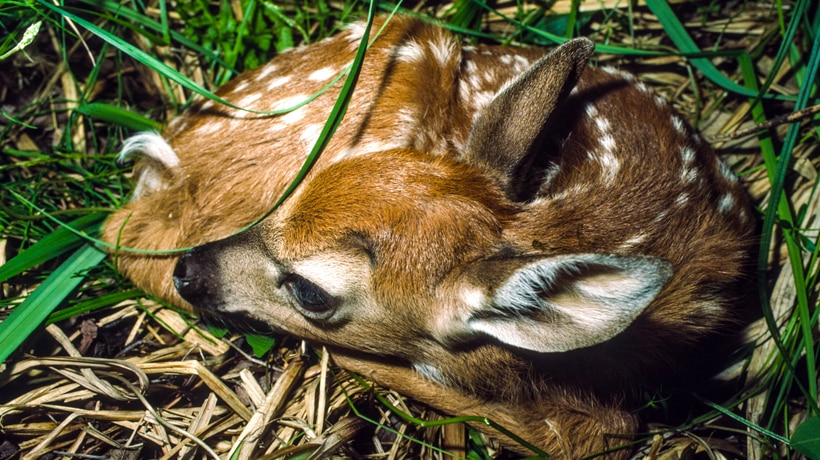Newborn or just-hatched wildlife venturing into the world on shaky legs or fragile wings and are sometimes discovered by people. Every year, the lives of many young wild creatures (fawns in particular) are upset by people who want to help. These people take baby wildlife from the wild in a mistaken attempt to save them. In fact, these well-meaning people are actually harming the young animals' chances of becoming normal adults. Remember, young wildlife belongs in the wild.
For young wildlife, the perils of survival are a natural part of ecology. Some will not survive. However, young animals that learn well from one or both parents and are the most fit usually live the longest. Early unsteady steps and flights are part of normal development, helping young animals learn to take care of themselves.
Some types of baby animals develop quickly; others need more parental care before they can fend for themselves. It is at this time that most of the problems arise. Some people assume that young wildlife they have found has been abandoned by the parents. They believe that the young animals are helpless and need to be saved. In nearly all cases, this is a mistake: the young animals are neither abandoned nor orphaned.
When people intervene
People with good intentions sometimes try to rescue or care for young wildlife. In fact, the opposite is true. Human involvement can cause a lot of problems for these young creatures. Animals brought into human care end up missing out on learning experiences needed to survive in the wild. Even worse, the animal may die at the hands of someone who doesn't fully know how to care for the animal.
Animals released into the wild are at a disadvantage, as they lack the skills needed to find natural food and cover. Young wildlife cared for by humans often end up attached to people, with little fear. This can lead to animals:
- Wandering into populated areas
- Attacked by domestic animals
- Hit by cars
- Getting into stored food, trashcans, or residences
- Injuring people
If you find young wildlife
If you want to avoid the problems related to people caring for wildlife, leave them alone! It may be very tempting to help these animals, but most of the time it isn't necessary. The adults are often nearby for protection, and visit their young from time to time. In the rare case you find a young animal with visible injuries or with its dead mother, you can contact a licensed wildlife rehabilitator for assistance. Find a list of wildlife rehabilitators here.
Keep your pets indoors or restrained
One way you can help wildlife without actually caring for it, is to keep your pets indoors or restrained. This helps wildlife as pets often like to chase and hunt songbirds and other mammals. This also helps your pets to avoid dangers posed by wild animals, other pets, or automobiles.
Leave fawns (young deer) where they are found
Fawns are safe when left alone because their camouflaging color help them remain undetected until the parent returns. Learn more about what to do if you find a fawn.
Finding birds
Young birds naturally have a low chance of survival, which keeps populations in balance with available resources. While baby birds may look helpless, they usually do not need your assistance unless you see visible signs of injury. If you find a hatchling or nestling (young birds without feathers) outside the nest, you can try to safely return it to its nest. The parents will not reject it if you touch it. If you find a fledgling (a young, fully feathered bird) outside the nest, leave it be. While it is spending some time hopping around on the ground learning how to fly, its parents are likely nearby still taking care of it.
Finding bunnies and other young mammals
Generally, young mammals are visited by their mother only a few times a day to avoid attracting predators to the young. For example, a nest of bunnies will only be visited by the adult female twice per day to nurse the young. The young are generally safe when left alone because their color patterns and lack of scent help them remain undetected. In most cases, it’s best to leave young animals alone.
Birds and mammals are protected under the law
Leaving wildlife alone is not only the smart thing to do for the animal, but for yourself as well. It is illegal to take an animal from the wild or keep one as a pet. Remember, if you care, leave them there!
Nearly all wild birds and mammals are protected under the law. They may not legally be taken from the wild or kept as pets. Never consider wildlife as possible pets; it is both illegal and unwise. They are wild animals that belong in the wild. An injured wild animal may be assisted, but a person must deliver the animal immediately to a licensed rehabilitator. MassWildlife licenses wildlife rehabilitators who are qualified to care for injured or truly orphaned wildlife. In cases where the services of a wildlife rehabilitator are required, names are available through the MassWildlife website or District offices.
